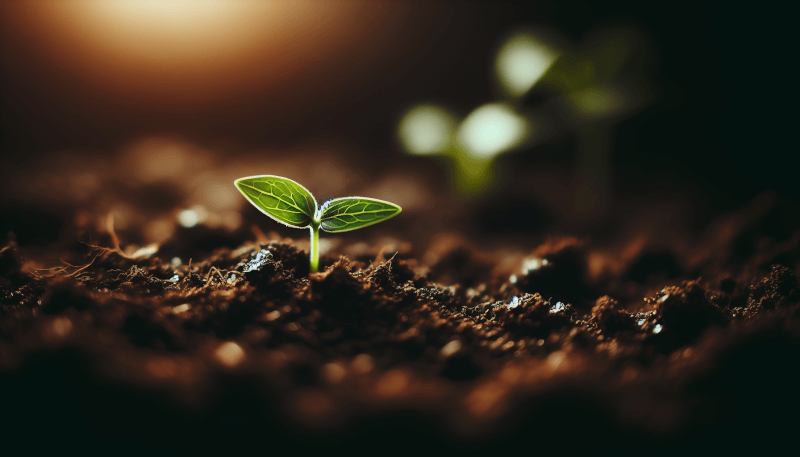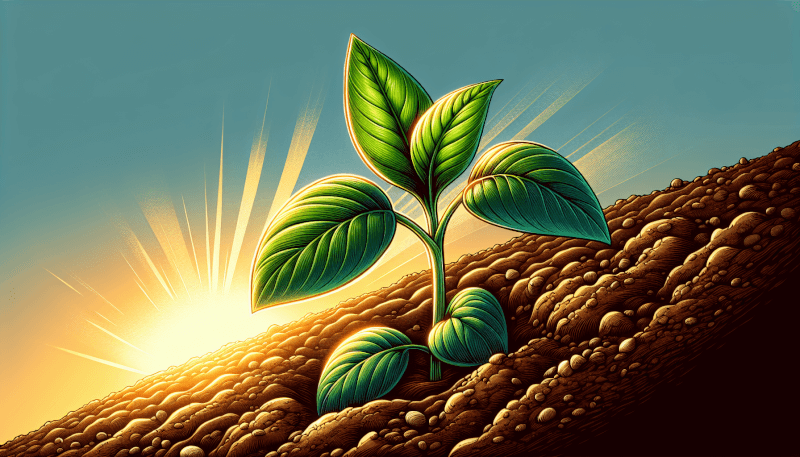👋 Click the mic button to talk to Alfred, the Todd's Seeds Gardening/Sprouting Expert – Feel free to ask him anything!
Ask Virtual Todd Anything - Click the Mic
If you’ve ever tried to grow plants from seeds, you know that successfully germinating them is the first crucial step. But what happens next? How do you ensure those tiny sprouts receive the care they need to flourish into thriving plants? In this article, we’ll guide you through the process of planting germinated seeds, providing you with essential tips and techniques that will help you nurture your plants from their very beginnings. Whether you’re an experienced gardener or a beginner with a green thumb, this article will equip you with the knowledge to successfully plant germinated seeds and set them up for a healthy growth journey.

Choosing the Right Seeds
When it comes to planting a garden, one of the most important steps is choosing the right seeds. There are a few factors to consider when selecting seeds for your garden.
Identify the Plant
Before you can choose the right seeds, you need to identify the plants you want to grow. Are you looking to plant vegetables, flowers, or herbs? Each plant has specific characteristics and requirements, so it’s essential to know what you’re working with.
Consider the Plant’s Requirements
Once you’ve identified the plants you want to grow, it’s important to consider their specific requirements. Some plants thrive in full sun, while others prefer partial shade. You should also consider the soil type and pH levels that the plants prefer. By understanding the specific needs of each plant, you can ensure that you choose seeds that will thrive in your garden.
Check for Germination Rates
Another critical factor to consider when choosing seeds is their germination rates. Germination refers to the process of a seed sprouting and turning into a seedling. It’s essential to choose seeds that have high germination rates to increase your chances of success. Look for seeds with high germination rates on the packaging or when purchasing from a reliable source.
Preparing the Planting Area
Once you have chosen the right seeds, it’s time to prepare the planting area. This step is crucial in ensuring that your plants have the best chance of success.
Select an Appropriate Location
The first step in preparing the planting area is selecting an appropriate location. Consider the specific requirements of the plants you are growing. Are they shade tolerant or sun-loving? Ensure that the location you choose provides the necessary amount of sunlight for your plants to thrive.
Clear the Planting Area
Before planting your seeds, it’s essential to clear the planting area of any debris, weeds, or grass. These can compete with your plants for nutrients and water. Use a rake or garden hoe to remove any obstructions and create a clean space for your seeds to grow.
Prepare the Soil
The quality of your soil is crucial to the success of your plants. Before planting, it’s vital to prepare the soil by loosening it with a garden fork or tiller. This allows the roots to penetrate easily and ensures proper drainage. Consider adding organic matter, such as compost or well-rotted manure, to improve the soil’s fertility. Mix the organic matter into the soil thoroughly to provide a nutrient-rich environment for your plants.
Germinating the Seeds
Germinating the seeds is an essential step in the planting process. This involves preparing the seeds for growth before they are planted in the garden.
Choose a Germination Method
There are several methods you can use to germinate your seeds, such as using seed trays, paper towels, or seedling plugs. Research the specific germination requirements of your chosen plants and choose the method that suits them best. Each method has its advantages and may require different levels of attention and care.
Prepare the Germination Medium
The germination medium refers to the material that provides support and moisture for the seeds during germination. It can be a soilless mix, vermiculite, or a combination of peat and perlite. Ensure that the germination medium is moist but not soaking wet to promote proper seedling development.
Plant the Seeds in the Germination Medium
Once you have prepared the germination medium, carefully place the seeds in it according to the recommended planting depth. Some seeds may require a light covering of the medium to protect them, while others may need to be left exposed. Gently press the seeds into the medium and mist with water to keep them moist. Place the seeds in a warm and well-lit area to encourage germination.
Transplanting Germinated Seeds
After the seeds have germinated and the seedlings are healthy, it’s time to transplant them into the garden. This step ensures that the seedlings grow and thrive in their new environment.
Prepare Seedling Pots
Before transplanting, prepare seedling pots or containers filled with a well-draining potting mix. This will give the seedlings a temporary home before being planted in the garden. Make sure the pots have drainage holes to prevent waterlogging.
Gradually Acclimate the Seedlings
Seedlings need to be acclimated to their new environment gradually. Start by placing them outdoors in a sheltered spot for a few hours a day, gradually increasing the exposure over several days. This process, known as hardening off, helps the seedlings adjust to temperature variations, wind, and sunlight.
Transfer the Seedlings to the Planting Area
Once the seedlings are acclimated, it’s time to transplant them into the garden. Choose a day when the soil is moist but not saturated. Gently remove the seedlings from their pots, taking care not to damage the roots. Dig a hole in the planting area slightly larger than the root ball of the seedling. Place the seedling in the hole, backfill with soil, and gently firm the soil around the roots. Water the seedlings well after transplanting to help them settle into their new home.

Caring for Germinated Seeds
To ensure the success of your germinated seeds, it’s crucial to provide them with the care they need to grow and thrive.
Provide Adequate Water
One of the most important factors in caring for germinated seeds is to provide them with adequate water. Water the plants deeply and consistently, ensuring that the soil remains moist but not waterlogged. Avoid letting the soil dry out completely, as this can stress the seedlings and impede their growth.
Ensure Sufficient Sunlight
Most plants require an adequate amount of sunlight to thrive. Place your garden in an area that receives the recommended amount of sunlight for the specific plants you are growing. Monitor the plants to ensure they are receiving enough sunlight. If needed, consider using shade cloth or other means to protect them from intense sun exposure.
Maintain Proper Temperature
Just like with sunlight, it’s crucial to maintain the proper temperature for your germinated seeds. Some plants thrive in cooler temperatures, while others prefer warmer conditions. Keep an eye on the weather forecast and provide protection for your plants during extreme temperatures to prevent stress and damage.
Protecting Germinated Seeds
Protecting your germinated seeds from potential threats is an essential part of their care. Here are some measures you can take to ensure their safety.
Implement Pest Control Measures
Pest infestations can devastate your garden and harm your germinated seeds. Implement pest control measures, such as using organic pesticides or employing natural methods like companion planting or insect deterrents. Regularly inspect your plants for any signs of pests and take action immediately to prevent further damage.
Guard Against Harsh Weather Conditions
Harsh weather conditions, such as strong winds, heavy rain, or frost, can pose a threat to your germinated seeds. Provide protection by using row covers, cloches, or other protective coverings that shield the plants from these extreme conditions. Remove the coverings once the danger has passed to allow proper air circulation.
Use Protective Coverings
Protective coverings, such as netting or physical barriers, can help safeguard your germinated seeds from animals or birds that may be tempted to eat them. Secure the coverings tightly to prevent access to the seedlings without causing damage to their fragile stems or leaves.

Providing Nutrients
Nutrients are essential for the healthy growth of your germinated seeds. Provide them with the necessary nourishment to support their development.
Choose the Right Fertilizer
Choosing the right fertilizer is crucial to ensure your germinated seeds receive the appropriate nutrients. Consider using organic fertilizers that provide a balanced mix of essential elements. Read the fertilizer packaging or consult a gardening expert to determine the correct type and application rate for your plants.
Apply Fertilizers at the Appropriate Times
Timing is crucial when applying fertilizers to your plants. Follow the recommended guidelines for each plant, as overfertilizing can lead to nutrient imbalances or burn the tender seedlings. Apply fertilizers evenly to the soil and water thoroughly to help the nutrients reach the roots.
Monitor Nutrient Levels
Regularly monitor the nutrient levels in your soil to ensure your germinated seeds are receiving the necessary nutrients. Soil testing kits are available to help you assess the nutrient content and make any necessary adjustments. Adjusting the nutrient levels based on the test results will promote healthier and more productive plants.
Pruning and Shaping Germinated Seedlings
Pruning and shaping your germinated seedlings not only helps them maintain an attractive appearance, but also promotes better plant health and growth.
Trimming Excess Growth
Remove any excess growth on your germinated seedlings, such as overcrowded or damaged stems and branches. Pruning encourages the development of stronger, more robust plants by redirecting the plant’s energy to essential areas.
Encourage Desired Plant Structure
Pruning is also an excellent opportunity to shape your plants into the desired structure. By selectively removing branches or pinching off growing tips, you can shape your germinated seedlings to create a more compact or bushy growth habit.
Promote Air Circulation
Proper air circulation is crucial for preventing diseases and promoting healthy growth. Remove any dense foliage or overlapping branches that may impede air movement. This helps reduce humidity levels and prevents the buildup of fungal diseases.

Identifying and Addressing Common Issues
Even with the best care, germinated seeds can still encounter common issues that need to be addressed promptly to prevent further damage.
Recognize Signs of Disease or Infection
Regularly inspect your germinated seeds for any signs of disease or infection. Look for discoloration, spots, wilting, or unusual growth patterns. If you notice any issues, research, or consult an expert to identify the problem accurately and take appropriate measures to mitigate it.
Treat Pest Infestations
Pests can wreak havoc on your germinated seeds if left untreated. Identify the pests and research suitable methods for controlling or eliminating them. Use organic pesticides or integrated pest management strategies to minimize harm to the environment. Regularly monitor your plants for signs of pest activity to catch infestations early and prevent widespread damage.
Manage Nutrient Deficiencies
Nutrient deficiencies can manifest in various ways, such as yellowing leaves, stunted growth, or poor flowering. If you notice any signs of nutrient deficiencies, adjust your fertilization practices by using a suitable fertilizer or supplementing with specific nutrients. Soil testing can help identify the specific nutrient deficiencies and guide you in the appropriate corrective actions.
Harvesting Germinated Seeds
After weeks or months of caring for your germinated seeds, the time will come to harvest the fruits of your labor.
Determine the Optimal Harvest Time
Research the optimal harvest time for each plant you have grown. Certain plants need to reach a specific stage of maturity before they can be harvested, while others should be harvested at specific times of day. Harvesting at the right time ensures the best flavor, texture, and nutritional value.
Properly Collect and Store the Seeds
When collecting seeds, ensure they are fully mature and dry. Remove seeds from the plants carefully and place them in airtight containers or seed packets. Label the containers with the plant species, variety, and harvest date to ensure proper identification later. Store the seeds in a cool, dark, and dry place to maintain their viability for future use.
Dispose of Any Unsuitable Seeds
During the harvesting process, you may encounter seeds that are discolored, damaged, or otherwise unsuitable for storage or future planting. Dispose of these seeds properly to prevent confusion and potential contamination of your seed collection. You can discard them in compost or garbage, but avoid planting or storing them with your viable seeds.
By following these comprehensive steps, you can ensure the successful growth and development of your germinated seeds. Remember to choose the right seeds, prepare the planting area, germinate the seeds, care for them diligently, protect them from threats, provide nutrients when needed, shape them through pruning, address issues promptly, and eventually harvest the fruits of your efforts. Happy gardening!
